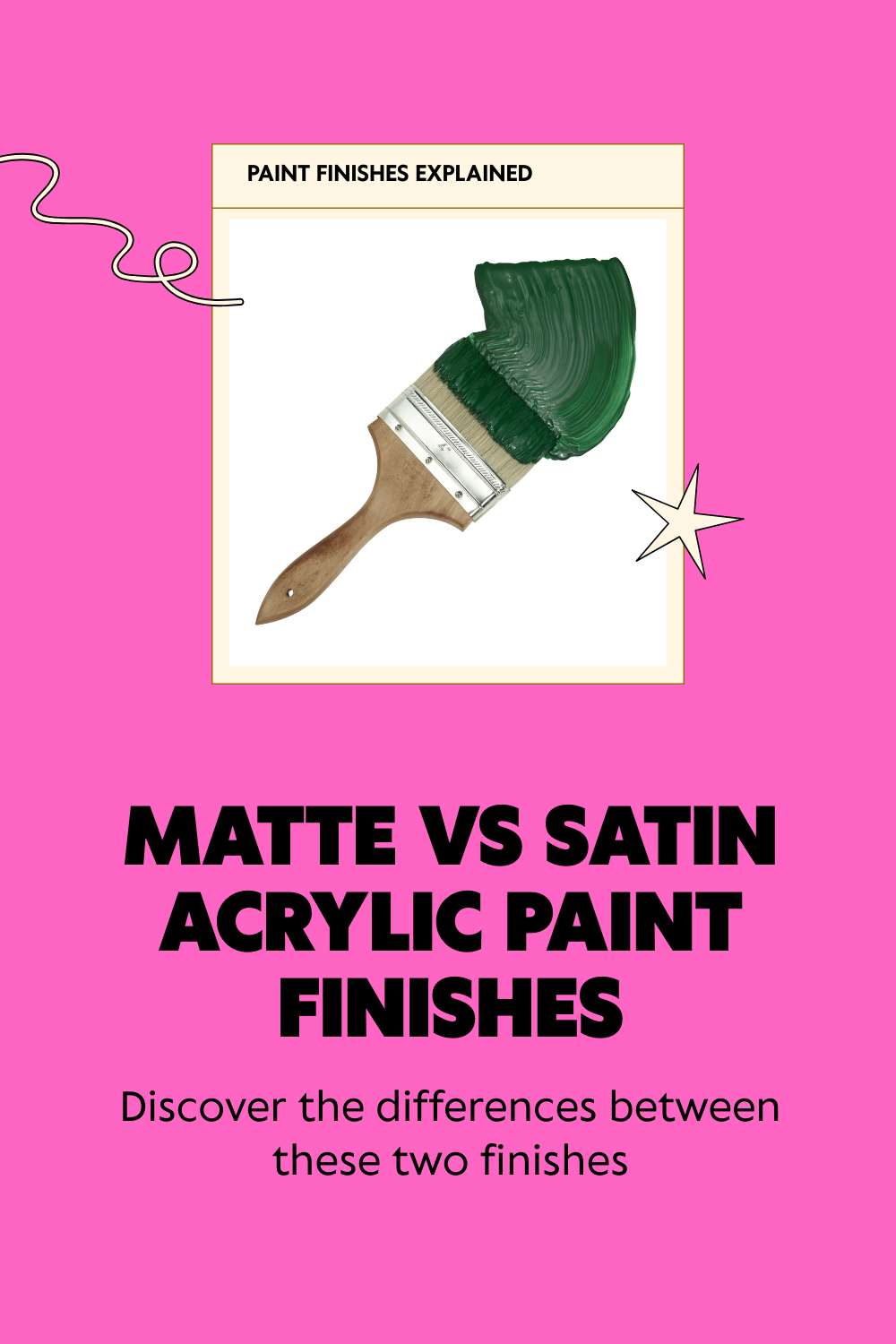Matte vs Satin Acrylic Paint
When I first got into painting and DIY projects, I quickly realized that choosing the right paint finish can feel overwhelming.
Daydreaming about a perfect brush stroke or a bold color isn’t enough because the finish you pick can entirely change the look and feel of your work.
Two of the most common finishes I found myself debating between were matte and satin acrylic paint.
After working on multiple projects and experimenting with both finishes, I’ve learned quite a bit about their differences, benefits, and ideal applications.
If you’re stuck deciding between matte and satin acrylic paint, I’ve got you covered. Pull up a chair because I’m breaking it all down for you.
What Exactly Are Matte and Satin Acrylic Paints?
Before we jump into comparisons, let’s clarify what these finishes actually mean. Acrylic paint comes in a variety of finishes, ranging from completely flat (matte) to super shiny (glossy).
Matte paint has a non-reflective, velvety texture that absorbs light, giving it a soothing and understated look.
On the other hand, satin paint strikes a balance between matte and glossy; it offers a soft sheen, reflecting just enough light to make colors pop without being too shiny.
The difference in appearance comes down to the composition of the paint. Satin finishes tend to have more binder (a component that adds durability and sheen), while matte finishes include more pigment and additives that reduce shine.
Understanding this basic distinction gave me a lot of clarity when deciding what would work best for a project.
Differences Between Matte and Satin Acrylic Paint
Here’s a closer side-by-side comparison that I wish someone had shared with me when I started.
1. Appearance
- Matte Paint: Matte finish is smooth, muted, and doesn’t reflect any light. If you’re going for a modern or minimalistic vibe, matte is perfect. It gives a soft, professional look and lets the color stand on its own.
- Satin Paint: Satin has a soft, semi-gloss appearance. It reflects just a bit of light, giving your paint a slight glow. This makes the finish feel a bit “livelier” than matte, which is great for adding dimension to projects.
2. Durability
- Matte Paint: Unfortunately, matte finishes aren’t always the most durable. Since they’re more prone to smudging, scratching, and staining, they can be a hassle to touch up. I learned this the hard way when I used matte paint on a high-traffic wall and ended up regretting it every time I tried to clean a smudge.
- Satin Paint: Satin is more durable and resistant to stains and marks. It’s easy to wipe down, which makes it suitable for areas that get a lot of use. If durability is a top priority for you, satin should be your go-to.
3. Color Intensity
- Matte Paint: Matte finishes have a way of softening colors. While some might consider this a downside, I personally adore the timeless and elegant vibe it brings. For muted tones, such as greys, pastels, or earth shades, matte can be absolutely perfect.
- Satin Paint: Satin, on the other hand, enhances color vibrancy. The slight light reflection gives deeper colors more dimension and energy, making them appear richer and bolder.
4. Ease of Application
- Matte Paint: What I love about matte finishes is how forgiving they are when applied. Small mistakes, like brush strokes or uneven coats, are much less noticeable. It’s my finish of choice when I don’t want to fuss over perfection.
- Satin Paint: Satin paint needs a bit more attention during application. Uneven coats or streaks stand out more, so you’ll probably need to be a bit more meticulous.
5. Cleaning and Maintenance
- Matte Paint: Cleaning matte finishes can be tricky. Scrubbing too hard or using a damp cloth often ends up removing pigment or leaving noticeable marks.
- Satin Paint: Cleaning satin is a breeze. A gentle wipe usually does the trick, making it a better choice for surfaces like furniture, walls, or areas prone to dirt and grime.
When to Choose Matte Acrylic Paint
Now that you know the basics, you might wonder when a matte finish is the right choice. Here’s when I personally turn to matte:
- For a Subtle, Sophisticated Look
Matte finishes excel in creating a soft and contemporary vibe. I’ve used it on feature walls, especially in bedrooms or offices, to create a calm, focused atmosphere. - Surfaces with Imperfections
If the surface you’re painting has minor flaws (e.g., dents or scratches), matte does a fantastic job of hiding them because it doesn’t reflect light. - Artwork and Custom Designs
Matte is great for acrylic painting on canvas, where you want your designs to speak without the distraction of gloss. I’ve completed several canvas projects with matte paint, and the results always feel elegant and polished. - Low-Traffic Areas
Matte isn’t the best for frequently used spaces. I reserve it for areas like ceilings, decorative items, or accent pieces, where it won’t experience much wear and tear.
When to Choose Satin Acrylic Paint
Satin acrylic paint, on the other hand, has its own set of advantages. Here’s when I tend to reach for satin:
- For a Clean and Modern Aesthetic
Satin paint’s subtle sheen works wonders in spaces that need a touch of shine. Living rooms, kitchens, and bathrooms are spaces where I’ve used satin paint to maintain vibrancy without the full-gloss glare. - High-Use and Easy-to-Clean Areas
If it’s a space that’s prone to dirt or fingerprints, satin is hands down your best option. I’ve used it on furniture, doors, and trim with excellent results. - Depth and Vibrancy
Satin brings colors to life, making them look more dynamic. If you’re working on bold or dark tones, like navy blue or forest green, satin can amplify their impact. - When You Need Longer Durability
For items or surfaces that need to last through handling, I lean toward satin because it resists scuffing better than matte.
Tips for Choosing the Right Finish
Here are some tips that have always helped me narrow down my choice:
- Assess the Surface and Usage: Think about how much wear the surface will endure. Matte works best for low-traffic areas, while satin is the way to go for anything that’s heavily used or in contact with moisture.
- Think About the Lighting: If your painting environment has lots of natural light, satin will reflect it beautifully without overwhelming the space. But in dimly lit areas, matte can create a cozier feel.
- Experiment First: Don’t be afraid to test both finishes on a small sample surface. I routinely swatch both matte and satin before committing to a project.
- Mix and Match: You don’t always need to pick just one! I’ve often combined finishes in a single room—for example, satin on the walls and matte on the ceiling—to create depth and balance.
Final Thoughts on Matte vs Satin Acrylic Paint
If I had to sum it up, the choice between matte and satin acrylic paint is all about the effect you want and the function of your project.
Matte paints offer understated elegance and are ideal for cozy, low-touch environments where maintenance isn’t a concern.
On the other hand, satin finishes deliver durability and vibrancy, making them perfect for high-use areas or when you want a touch of polished flair.
Over time, I’ve come to appreciate both finishes for their unique strengths. Whether I’m painting a piece of furniture, designing canvas art, or transforming a room, I always start by considering the end goal.
Hopefully, this guide helps you feel confident in making the right call for your own projects. Good luck, and happy painting!


